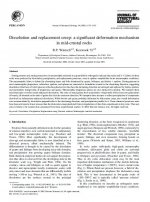Добрый день, Коллеги. Важное сообщение, просьба принять участие. Музей Ферсмана ищет помощь для реставрационных работ в помещении. Подробности по ссылке
Dissolution and replacement creep: a significant deformation mechanism in mid-crustal rocks
Zoning patterns and zoning truncations in metamorphic minerals in a granodioritic orthogneiss indicate that strain and S-C fabrics in these rocks were produced by dissolution, precipitation, and replacement processes, even at epidote-amphibolite fades metamorphic conditions. The metamorphic fabric is defined by alternating layers and folia dominated by quartz, feldspars, and biotite + epidote. Zoning patterns in most metamorphic plagioclase, orthoclase, epidote, and sphene are truncated at boundaries normal to the shortening direction, suggesting dissolution. Interfaces of relict igneous orthoclase phenocrysts that face the shortening direction are embayed and replaced by biotite, epidote, and myrmekitic intergrowths of plagioclase and quartz. Metamorphic plagioclase grains are also replaced by epidote. We interpret these microstractures to reflect strain-enhanced dissolution. The cores of many grains show asymmetric overgrowths with at least two generations of beards, all oriented on the ends of grains that face the extension direction. We interpret these textures to reflect precipitation of components dissolved by deformation-enhanced dissolution. While biotite and quartz probably deformed by dislocation creep, the overall deformation was accommodated by dissolution perpendicular to the shortening direction, and precipitation parallel to it. These chemical processes must have been activated at lower stresses than the dislocation creep predicted from extrapolations of data from experiments in dry rocks. Thus wet crust is likely to be weaker than calculated from these experimental studies




